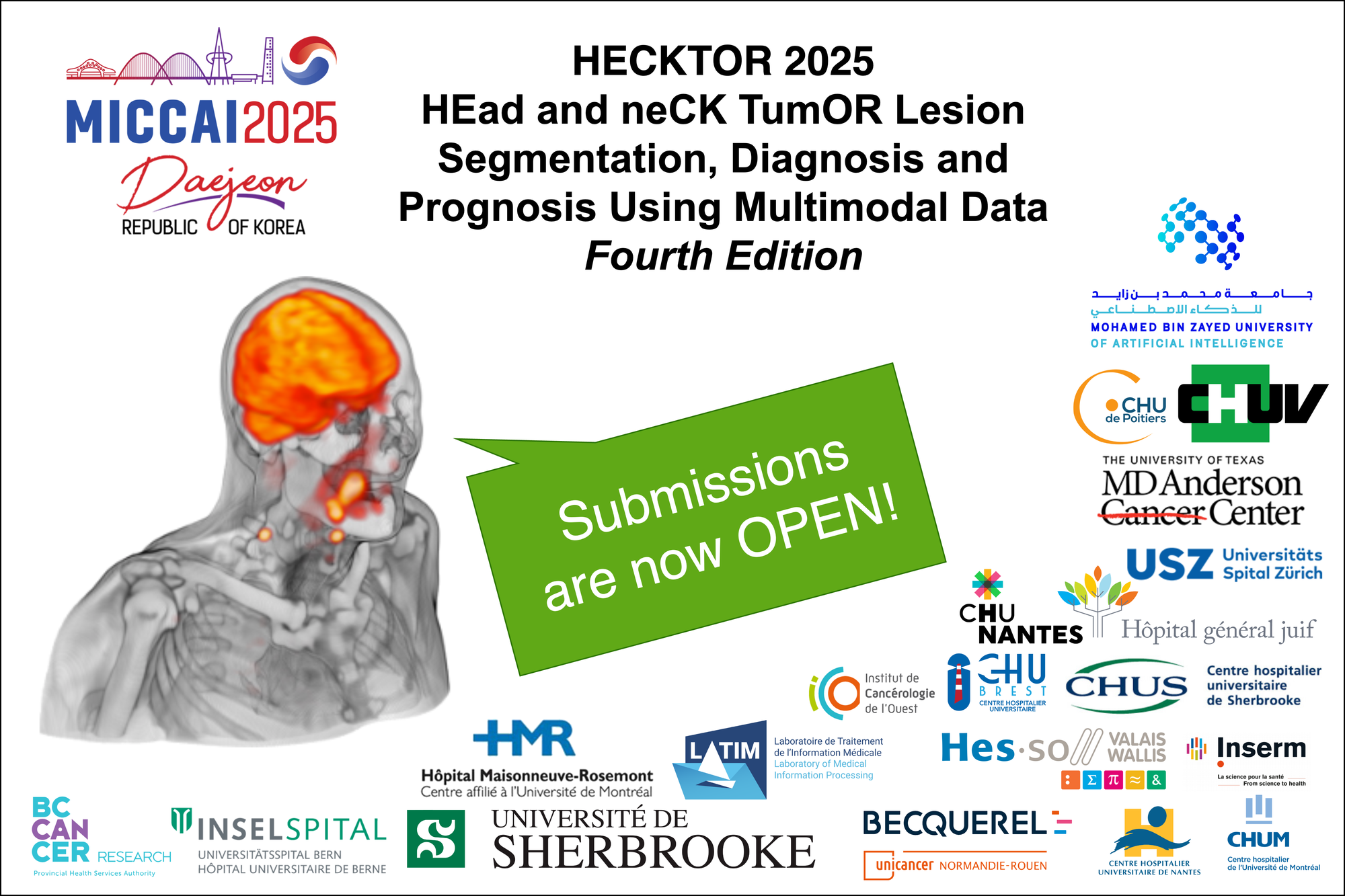HEad and neCK TumOR Lesion Segmentation, Diagnosis and Prognosis¶
🚨 Testing Phase is now Open!¶
Check Submission Instructions Here.

Following the success of the first editions of the HECKTOR challenge from 2020 through 2022, this challenge will be presented at the 28th International Conference on Medical Image Computing and Computer-Assisted Intervention (MICCAI) 2025 in Daejeon, South Korea. Three tasks are proposed this year (participants can choose to participate in any or all tasks):
- Task 1: The automatic detection and segmentation of Head and Neck (H&N) primary tumors and lymph nodes in FDG-PET/CT images;
- Task 2: The prediction of Recurrence-Free Survival (RFS) from the FDG-PET/CT images, available clinical information, and radiotherapy planning dose maps;
- Task 3: The diagnosis of HPV status from the FDG-PET/CT images and available clinical information.
Head and Neck (H&N) cancers are among the most common cancers worldwide (5th leading cancer by incidence) [Parkin et al. 2005]. Radiotherapy combined with cetuximab has been established as a standard treatment [Bonner et al. 2010]. However, locoregional failures remain a major challenge and occur in up to 40% of patients in the first two years after the treatment [Chajon et al. 2013]. Recently, several radiomics studies based on Positron Emission Tomography (PET) and Computed Tomography (CT) imaging were proposed to better identify patients with a worse prognosis in a non-invasive fashion and by exploiting already available images such as those acquired for diagnosis and treatment planning [Vallières et al. 2017; Bogowicz et al. 2017; Castelli et al. 2017]. Although highly promising, these methods were validated on relatively small cohorts of patients. Further validation on larger, multicentric cohorts (>1200 patients) is required to ensure an adequate ratio between the number of variables and observations to avoid an overestimation of the generalization performance.
For the 2025 edition of HECKTOR, we propose the following updates and additions to improve the clinical relevance, increase the interest of competitors, and add novelty:
- All data included in the 2022 edition (~850 patients) will be updated as much as possible, especially regarding the previously missing clinical information, such as the HPV status, which is highly clinically relevant, and the follow-up (to increase the duration of follow-up and potentially the number of recorded recurrence events). This will constitute the training set of 2025.
- Two new French cohorts joined the consortium, constituting a new, previously unseen test set (total of ~400 patients). The 2025 database should, therefore, include more than 1200 patients from at least 11 centers.
- The segmentation task (Task 1) will be the same as in 2022 [Andrearczyk et al. 2022]. Still, the evaluation will be refined using more appropriate metrics to differentiate better algorithms' ability to detect multiple distinct lesions in addition to segmenting them.
- Regarding the outcome prediction task, it will be split into a diagnostic task (new Task 3) with high clinical relevance, i.e. the prediction of the HPV status from images and clinical data, in addition to the RFS prediction (Task 2, same as in 2022), which will be expanded by providing updated clinical information, and dose maps (+ dosimetry CT) of the radiotherapy planning as an added information channel to include in the prediction models, for an estimated 187 patients in training and 450 in testing.
By focusing on metabolic and morphological tissue properties, respectively, PET and CT modalities include complementary and synergistic information for cancerous lesion segmentation as well as tumor characteristics potentially relevant for patient outcome prediction and HPV status diagnosis, in addition to usual clinical variables (e.g., age, gender, treatment modality, etc.). Modern image analysis (radiomics, machine, and deep learning) methods must be developed and, more importantly, rigorously evaluated, in order to extract and leverage this information.
REFERENCES¶
[Andrearczyk et al. 2022] Andrearczyk V, et al. "Overview of the HECKTOR Challenge at MICCAI 2021: Automatic Head and Neck Tumor Segmentation and Outcome Prediction in PET/CT Images", in: Head and Neck Tumor Segmentation and Outcome Prediction, 1-37 (2022).
[Bonner et al. 2010] Bonner, James A., Paul M. Harari, Jordi Giralt, Roger B. Cohen, Christopher U. Jones, Ranjan K. Sur, David Raben, et al. 2010. “Radiotherapy plus Cetuximab for Locoregionally Advanced Head and Neck Cancer: 5-Year Survival Data from a Phase 3 Randomised Trial, and Relation between Cetuximab-Induced Rash and Survival.” The Lancet Oncology 11 (1): 21–28.
[Bogowicz et al. 2017] Bogowicz M, et al. "Comparison of PET and CT radiomics for prediction of local tumor control in head and neck squamous cell carcinoma." Acta Oncologica 56.11 (2017): 1531-1536.
[Castelli et al. 2017] Castelli J, et al. "A PET-based nomogram for oropharyngeal cancers." European Journal of Cancer 75 (2017): 222-230.
[Chajon et al. 2013] Chajon E, et al. "Salivary gland-sparing other than parotid-sparing in definitive head-and-neck intensity-modulated radiotherapy does not seem to jeopardize local control." Radiation Oncology 8.1 (2013): 1-9.
[Parkin et al. 2005] Parkin DM, et al. "Global cancer statistics, 2002." CA: a cancer journal for clinicians 55.2 (2005): 74-108.
[Vallières et al. 2017] Vallières M, et al. “Radiomics strategies for risk assessment of tumour failure in head-and-neck cancer.” Nature Scientific Reports, 7(1):10117 (2017).
